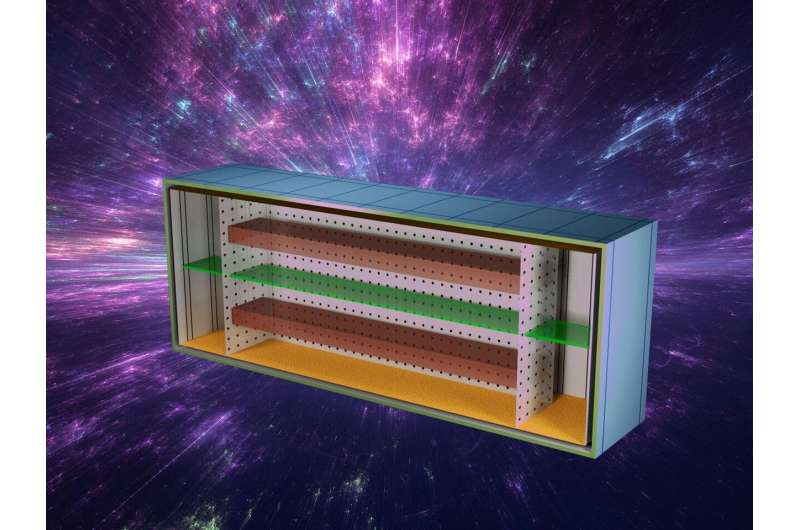This article has been reviewed according to Science X's editorial process and policies. Editors have highlighted the following attributes while ensuring the content's credibility:
fact-checked
trusted source
proofread
Designing detectors for DUNE

The most abundant, massive particles in the universe may be ones you've never even heard of: neutrinos. These particles are all around us—even streaming through us—though they almost never interact with other particles. They are so light and weakly interacting that no one has recorded their mass.
Physicists—including Pacific Northwest National Laboratory (PNNL) researchers Chris Jackson and Eric Church—believe that key questions about the creation of matter could be answered by neutrinos. Jackson and Church—along with over 1,700 other scientists from 38 countries—investigate these particles as part of the Deep Underground Neutrino Experiment (DUNE). Through DUNE, an international team of scientists aims to build ultrasensitive detectors to understand these elusive particles. Jackson, Church, and a team of university and national laboratory collaborators recently published a paper detailing a new detector design that can be fine-tuned to increase sensitivity to physics beyond the original DUNE concept. They performed simulations to examine the detector's abilities with the help of an aspiring high school physics teacher. Their results were published in the Journal of Physics G, whose editors selected the paper as a cover-page article.
Preparing for DUNE
Studying tiny particles takes some big equipment. When DUNE is fully constructed, neutrinos will begin their journey at the Long-Baseline Neutrino Facility located at the Fermi National Accelerator Laboratory (Fermilab) in Batavia, Illinois. They'll pass through one detector (the "near detector") before traveling roughly 800 miles to a much larger detector (the "far detector") at the Sanford Underground Research Facility in Lead, South Dakota.
The far detector of DUNE is made up of four different modules, each roughly three times the size of an Olympic swimming pool. Together, these modules will hold nearly 70,000 tons of liquid argon. Argon's large nuclei interact with the neutrino beam to produce a distinctive signal that the detectors can identify.
This is where Jackson and Church come in. They designed SLoMo—the Sanford Underground Low background Module—as a proposed new detector design. SLoMo features additional shielding, stringent radioactive background control, and enhanced light detection, making their module potentially more powerful than DUNE's first two planned modules. Specifically, the SLoMo design enhances DUNE's sensitivity to neutrinos emitted from sources other than the beam of neutrinos created at Fermilab. The SLoMo design makes it possible for DUNE to study neutrinos from supernova explosions as well as neutrinos emitted by the sun.
"Radioactive background noise—like neutrons from surrounding rocks—can interfere with neutrino signals," said Jackson. "Controlling radioactive backgrounds is something we do very well at PNNL. We wanted to see how much extra physics we could do if we could control the radioactive backgrounds in DUNE."
"PNNL brings the low background expertise to increase the scope of the physics of the DUNE detector," said Church. "Our module proposal was unique in that we performed a lot of simulations to find out exactly what physics measurements our detector would be able to make."
"The work Chris and Eric are doing to lead the community to build a more capable science experiment is impressive," said John Orrell, sector manager of the High Energy Physics program at PNNL. "They are helping the high energy physics community understand—in a quantitative way—how much more science can be achieved with DUNE."
From DUNE to the classroom
To help them run simulations to test SLoMo, Jackson and Church recruited Sylvia Munson—a high school physics teacher then in her junior year of college. Munson began her research journey through the STEM Teacher and Research (STAR) program that PNNL participates in.
Munson worked with Jackson and Church in 2020 and 2021 as part of the STAR summer research program though PNNL's Office of STEM Education. She performed some of the integral simulations that show the capabilities of SLoMo—earning her authorship on the Journal of Physics G publication.
Because of her positive experience with PNNL's internship program, Munson encourages her high school physics students to join summer research programs as early as possible. She even includes elements of her PNNL research in her curriculum.
"As a first-generation college student, I never dreamed I would be involved in something like this," said Munson. "Now I encourage everyone to apply."
More information: T Bezerra et al, Large low background kTon-scale liquid argon time projection chambers, Journal of Physics G: Nuclear and Particle Physics (2023). DOI: 10.1088/1361-6471/acc394
Provided by Pacific Northwest National Laboratory




















